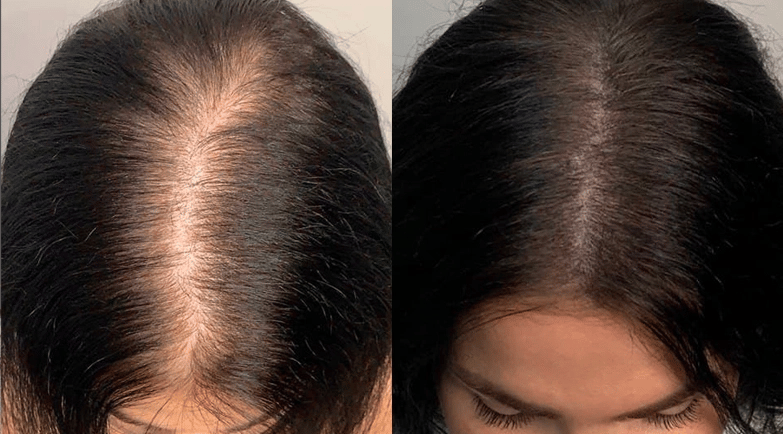Free Consultation, Call Now 416-902-2126
The Ultimate Guide to Scalp Micropigmentation for Thicker, Fuller-Looking Hair
Scalp micropigmentation (SMP) is a non-surgical solution for creating the appearance of thicker, fuller hair. This ultimate guide covers everything you need to know, from how SMP works and what to expect during treatment to aftercare tips and long-term benefits. Whether you're dealing with thinning hair, bald spots, or receding hairlines, SMP can provide a natural-looking, confidence-boosting solution. If you're considering SMP, AtruBarber in Oshawa offers expert treatments to help you achieve the perfect look.
2/22/20254 min read


What is Scalp Micropigmentation?
Scalp micropigmentation (SMP) is a non-invasive cosmetic procedure designed to simulate the appearance of hair follicles on the scalp. This innovative technique offers a solution for individuals experiencing hair loss due to various conditions, including pattern baldness, thinning hair, and alopecia. The origins of scalp micropigmentation can be traced back to tattooing, with advancements in technology allowing practitioners to create natural-looking results that blend seamlessly with existing hair.
The procedure involves the careful application of specialized pigments into the dermal layer of the scalp using precise techniques. This is achieved through the use of advanced equipment, such as digital machines equipped with fine needles that deposit the pigment at the appropriate depth and density. These advancements ensure that the results appear realistic, mimicking the look of short hair follicles. Skilled practitioners can create a range of shades that match the individual's natural hair color, providing a cohesive look that enhances self-esteem and confidence.
Scalp micropigmentation is versatile, catering to a wide array of clients. Those suffering from genetic conditions like androgenetic alopecia, as well as people who experience hair loss due to medical conditions or trauma, can particularly benefit from this treatment. Individuals seeking to enhance the density of thinning hair or achieve a buzzed hairstyle also find SMP to be a valuable option. By creating the illusion of fuller hair, this procedure can significantly impact one’s perceived age and overall appearance, making it an appealing choice for those prioritizing aesthetics. In essence, scalp micropigmentation offers an effective and lasting solution for individuals seeking to combat the challenges posed by hair loss.
The Benefits of Scalp Micropigmentation
Scalp micropigmentation (SMP) offers a myriad of benefits for individuals seeking to improve the aesthetic appearance of their hair. One of the primary advantages of SMP is its ability to create the illusion of thicker, fuller hair, making it an attractive option for both men and women experiencing hair thinning or hair loss. This technique utilizes specialized pigments that are deposited into the scalp, effectively camouflaging the scalp and providing a uniform appearance that mimics the look of closely shaved hair follicles.
Beyond the aesthetic benefits, many clients report a significant increase in confidence following their SMP procedure. The transformative results can lead to a more positive self-image, allowing individuals to feel more comfortable and confident in social and professional situations. This psychological uplifting effect is often cited as one of the key motivators for pursuing scalp micropigmentation over other hair restoration methods.
Another advantage of scalp micropigmentation is the minimal upkeep it demands compared to other hair restoration solutions. Unlike hair transplants that may require ongoing maintenance or specific hair care routines to sustain the results, SMP has a relatively low maintenance requirement. Most individuals simply need to follow basic skincare routines and schedule periodic touch-ups to uphold the integrity of the pigmentation. Furthermore, the non-invasive nature of this procedure draws many to consider SMP. Unlike surgical options, which can involve significant recovery time and potential complications, SMP offers a quick solution with minimal disruption to daily life.
Cost-effectiveness also plays a vital role in the appeal of scalp micropigmentation. The procedure generally requires a lower financial commitment compared to surgical hair restoration solutions. Additionally, the rapid healing time further enhances its attractiveness, with most clients resuming their regular activities soon after treatment. Therefore, SMP emerges as a practical, effective solution for those in search of a fuller appearance and enhanced self-esteem.
Choosing the Right Practitioner
When considering scalp micropigmentation, selecting the right practitioner is a crucial step to achieving a natural and satisfying outcome. The effectiveness of this procedure largely depends on the skill and experience of the individual administering it. Therefore, evaluating potential practitioners critically is essential. Start by examining their experience level; ideally, they should have specialized training in scalp micropigmentation, along with a portfolio showcasing their previous work. This portfolio should include before-and-after photos of past clients, which can provide insight into their capabilities and artistic style.
Certifications play a significant role in determining a practitioner’s qualifications. A certified professional is typically more adept, having undergone rigorous training and education in this specific technique. Additionally, licensing is an important factor to consider, as it ensures practitioners adhere to health and safety regulations. Client reviews are another valuable resource; they offer direct feedback from individuals who have undergone the procedure. Check online reviews and testimonials to assess overall patient satisfaction and to identify any recurring concerns.
Before making a decision, schedule an initial consultation with the chosen practitioner. This meeting provides an opportunity to discuss your specific needs and desired results. During the consultation, inquire about the techniques they use, the types of pigments employed, and whether they customize their methods based on individual client requirements. It’s vital to ensure that the practitioner understands your vision and can articulate how they plan to achieve it. A comfortable rapport between you and the practitioner is essential, as effective communication is key to producing the desired outcome. By considering these factors, you can select a qualified practitioner capable of delivering the results you seek through scalp micropigmentation.
Aftercare and Maintenance of Scalp Micropigmentation
Following the scalp micropigmentation (SMP) procedure, proper aftercare is crucial to ensure optimal results and longevity. For the first few days post-treatment, it is imperative to avoid any activities that may cause excessive sweating, such as strenuous exercise, saunas, or hot showers. Instead, opt for gentle washing of the scalp with lukewarm water and a mild, sulfate-free shampoo to protect the tattooed areas. This helps minimize irritation and prevents the healing process from being compromised.
During the healing phase, which typically lasts about 7 to 10 days, it is important to refrain from direct sun exposure. Prolonged UV exposure can lead to fading of the pigmentation, adversely impacting the longevity of the results. If you must be outdoors, consider wearing a hat or applying a high-SPF sunblock on the scalp to provide protection. Additionally, avoid using hair products containing alcohol or strong chemicals, as these can irritate the skin and interfere with the healing process.
For maintaining the appearance of your scalp micropigmentation, it is advised to schedule follow-up sessions and touch-ups every 2 years. The longevity of SMP can vary depending on skin type, lifestyle, and aftercare practices, with most clients enjoying vibrant results for about 18 months before requiring maintenance. During these touch-up appointments, the technician can assess fading and refresh pigmentation to ensure the scalp continues to appear fuller and more defined.
In conclusion, the aftercare and maintenance of scalp micropigmentation play an essential role in maximizing the treatment's benefits. Adhering to these guidelines not only aids in recovery but also enhances the overall aesthetic, allowing individuals to enjoy thicker, fuller-looking hair for an extended period. Following a disciplined aftercare regimen is the key to maintaining a crisp, natural look long after the initial procedure.
